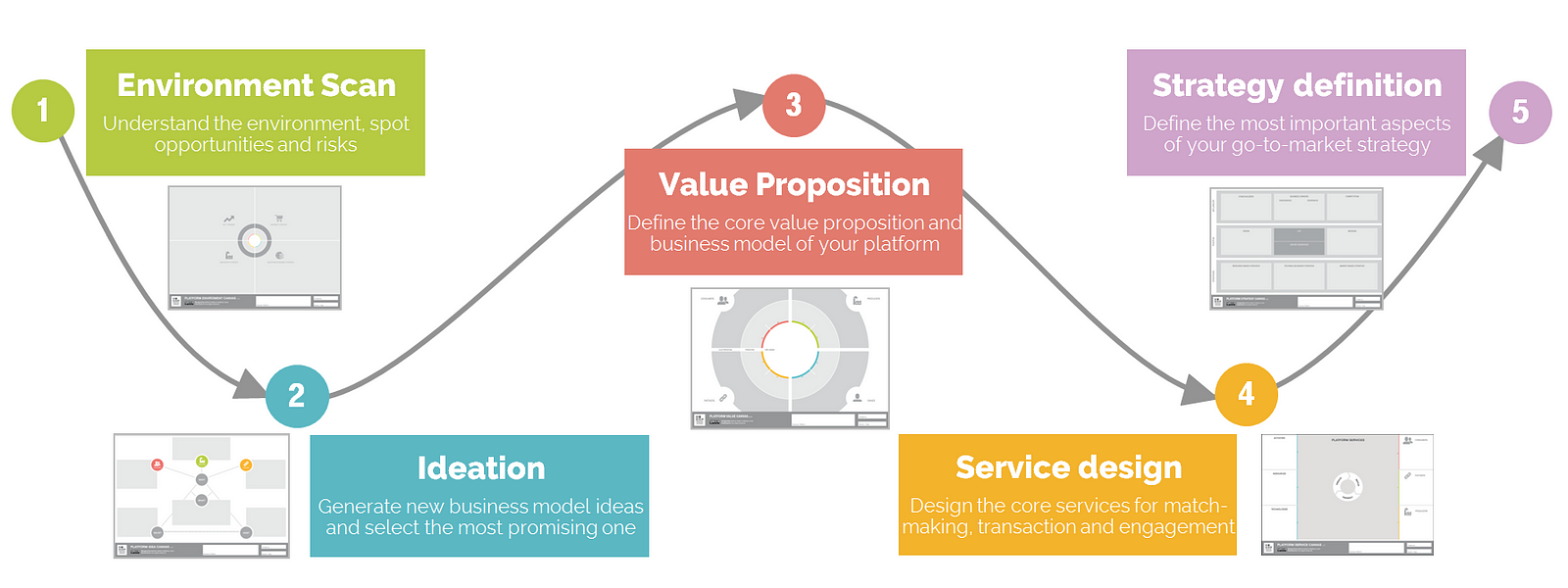Digital Platforms, marketplaces or multi-sided markets are core of all Digital Transformation stories, dreams of startups and goals of almost all corporations. There is also a lot of literature (see our top 10 reading list)talking in theory about the platform business model.

The Platform Innovation Kit (PIKiT)
Is a methodology we created in order to help startups and corporations invent, build and optimism platform based business models. The toolkit is easy to understand, practical and accessible for free.
Follow this 5-step process to learn how to ideate, design and strategize new platforms business model with solid results.
1The Environment Scan : Is all about understanding the context of the potential market. We scan the environment in 4 dimensions for value creation opportunities, weak spots in the markets and risks:
- Key trends
- Market forces
- Industry forces
- Macro economic forces
2The Ideation phase : Is where we use the Platform Idea Canvas to go broad — generating as much ideas for new business models as possible. Building platforms has a lot to do with disruption and therefore we put no constraints on the thinking. We use a sub-set of tools to foster the ideation like :
- Pattern Cards
- Challenger Cards
- Value Chain Models
At the end we usually generate between 15–30 new ideas. With methods like Priority Poker and Portfolio Management you can rank the ideas between market attractiveness, competition and the own strengths you bring to the table. The goal is to select 1 or 2 ideas you want to design deeper.
3Value Proposition: Now we come to the core of our approach. Here we use the Platform Value Canvas or Platform Business Model Canvas to design the platform ecosystem:
- Who are the consumers, producers and partners?
- What are the value propositions for them?
- What are important transactions?
- What is the business model (how do you earn money)?
This step is critical, since you need to get the value proposition right for each stakeholder, otherwise no one will join your platform. We start with co-innovation methodologies to understand the “jobs-to-be-done”, pains and gains of customers, producers and partners. Is better to get a deep understanding of your value propositions if you don’t want to investing in big prototyping — a low cost feedback loop.
4Service Design: In this phase we go deeper into the platform business model by focusing on the design of the key services that will:
- Match the stakeholders
- Enable the transactions for value exchange
- Keep the stakeholders engaged on the platforms
Here we also understand what is needed from you as the platform owner in order to operate the platform (key activities, key resources, key technologies), this is critical since it will help you understand the cost side of running the platform.
During this phase we go into “Service Design” sessions using design thinking and further co-innovation methodologies in order to create the platform architecture.
5Strategy: In the last step we look at the go-to-market strategy and consolidate the platform business model into one chart. This will help you talk to investors and get a high-level understanding of your idea. You will define your market position (Vision, Mission, USP), your influencers(competition, business drivers, stakeholders) and your strategies (market-strategy, resource strategy, business case).
This step is very helpful to really get the complete picture right, by talking about the business case in details you can understand how much money is needed and how network effects will help.
